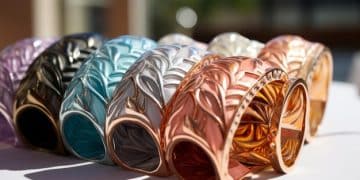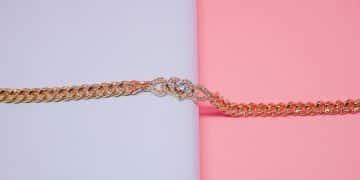Unmasking Fashion Jewelry Prices: What Really Drives the Cost?
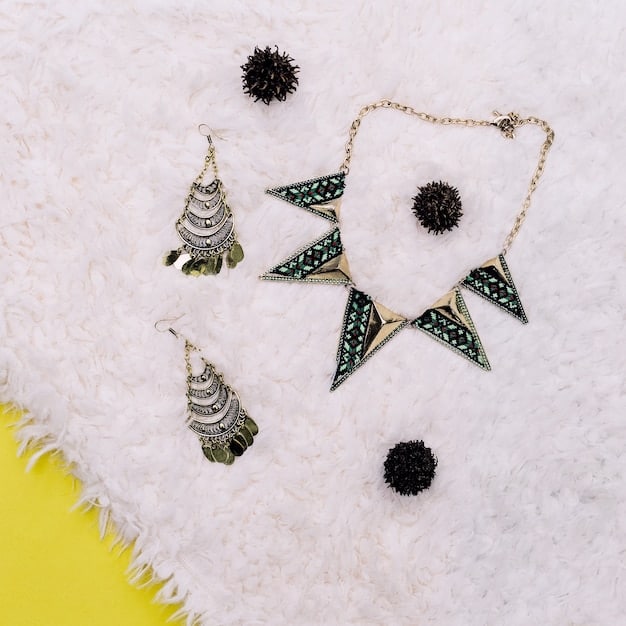
The price of fashion jewelry is influenced by a complex interplay of material costs, design intricacy, brand reputation, marketing expenses, and distribution channels, often reflecting perceived value more than intrinsic worth.
Ever wondered about The Truth About Fashion Jewelry Prices: What You’re Really Paying For? It’s a question that often lingers in the minds of style enthusiasts and savvy shoppers alike. This deep dive aims to demystify the seemingly opaque world of costume and fashion jewelry pricing, peeling back the layers to reveal the underlying factors that contribute to the tags you see, from design to distribution.
Deciphering the Materials: Beyond Gold and Diamonds
When we think of jewelry, our minds often jump to precious metals and gemstones. However, fashion jewelry operates on an entirely different material palette, and understanding these components is the first step in unraveling its pricing structure. Unlike fine jewelry, which derives much of its value from intrinsic material worth, fashion jewelry relies on a blend of creativity, technology, and aesthetic appeal to command its price points.
The core materials in fashion jewelry are diverse, ranging from plated metals to various forms of synthetic stones and glass. Base metals like brass, copper, and zinc alloys are commonly used, often coated with thin layers of gold, silver, or rhodium to mimic the appearance of more expensive counterparts. This plating process is a significant cost factor, with the thickness and quality of the plating directly impacting durability and, consequently, price.
Synthetic stones, such as cubic zirconia, crystals, and various forms of glass, are meticulously cut and polished to resemble natural diamonds and gemstones. While these materials are significantly less expensive than their natural counterparts, the quality of their cut, clarity, and overall finish can vary widely. Higher quality synthetic stones, often produced by reputable manufacturers like Swarovski, involve advanced manufacturing techniques that add to their cost.
Beyond metals and stones, materials like enamel, resin, plastics, wood, and even textiles are increasingly incorporated into fashion jewelry designs, offering a vast spectrum of textures, colors, and design possibilities. The origin and treatment of these non-traditional materials can also influence pricing. For instance, ethically sourced wood or custom-colored resins can elevate a piece’s value due to their unique properties and production efforts.
The Role of Component Sourcing and Quality
The global supply chain for fashion jewelry components is complex. Manufacturers source materials from various countries, with significant variations in quality and cost. Components from regions with stringent labor laws and quality control standards typically incur higher costs than those from areas with less regulated production environments. This isn’t just about ethics; it’s about the consistency and durability of the finished product.
- Metal Purity and Plating Thickness: A thicker gold or silver plating will last longer and resist tarnishing better, justifying a higher price.
- Stone Clarity and Cut: Even for synthetic stones, a precise cut and high clarity enhance sparkle and visual appeal, indicating better quality.
- Allergen-Free Materials: Increasing demand for hypoallergenic jewelry (e.g., nickel-free alloys) often means using more expensive base metals, affecting the final price.
- Ethical Sourcing: As consumers become more conscious, the use of ethically sourced materials or recycled components can add a premium, reflecting responsible manufacturing.
Understanding the provenance and quality specifications of the materials can provide valuable insights into why two seemingly similar pieces of fashion jewelry might have vastly different price tags. It’s not just about what it looks like, but what it’s made of and how those components were acquired and processed.
The Art of Design: From Concept to Creation
One of the most powerful, yet often invisible, drivers of fashion jewelry prices is the design itself. Unlike a raw commodity, a piece of jewelry embodies creative vision, intricate craftsmanship, and often, intellectual property. The journey from a nascent idea to a tangible accessory involves various stages, each contributing to the final cost. This is where fashion jewelry truly differentiates itself from mere material assemblages, becoming a wearable form of art.
Conceptualization begins with market research and trend forecasting. Designers analyze upcoming fashion trends, societal shifts, and consumer preferences to envision pieces that resonate with the target audience. This initial phase, while not directly involving physical production, requires significant investment in talent and data analysis. A design that perfectly captures the zeitgeist can naturally command a higher price due to its immediate relevance and desirability.
Following conceptualization, the design moves into sketching, digital rendering, and prototyping. Highly skilled designers and CAD (Computer-Aided Design) specialists are employed to translate ideas into precise technical drawings and 3D models. Prototyping, often involving 3D printing or master mold creation, allows for physical evaluation and refinement before mass production. These specialized skills and tools contribute substantially to the overheads.
Beyond the initial design, the complexity of a piece’s construction is a major factor. A simply cast pendant will be less expensive to produce than a multi-component necklace featuring intricate filigree work, numerous stone settings, and articulate joints. Hand-finishing, such as delicate enamel work, hand-setting individual stones, or intricate polishing, significantly increases labor costs compared to machine-finished items.
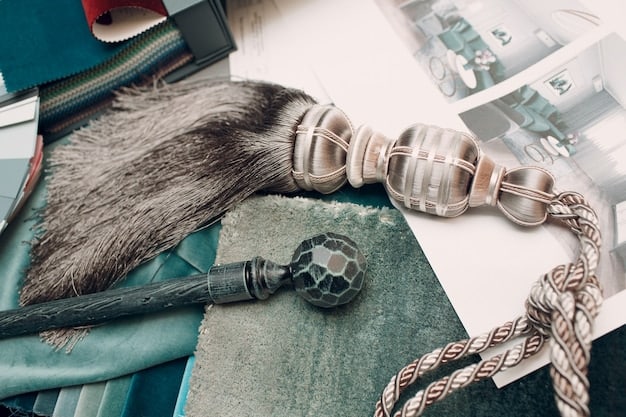
Consider the difference between a mass-produced, machine-stamped earring and a handcrafted, artisan-designed pendant. The latter often involves hours of dedicated human labor, skilled artistry, and unique techniques that cannot be replicated at scale. This exclusivity and the story behind the piece add to its perceived and actual value.
The Impact of Design Complexity and R&D
Brands that invest heavily in research and development (R&D) to create innovative materials, unique finishes, or proprietary manufacturing processes often pass these costs onto the consumer. This R&D can lead to novel designs that are more durable, more comfortable, or simply stand out in a crowded market.
- Originality and Uniqueness: Pieces with truly original designs, especially those that set new trends, are priced higher than generic, imitation styles.
- Craftsmanship and Labor: Hand-assembled or hand-finished pieces require more skilled labor, escalating production costs significantly.
- Innovation in Construction: Patented clasps, convertible designs, or modular pieces that offer versatility are examples of design innovations that add value.
Ultimately, the design component encompasses not just the aesthetic appeal but also the ingenuity, skill, and labor-intensive processes involved in bringing a unique piece of fashion jewelry to life. This intellectual and artistic capital is fundamental to its pricing.
Brand Reputation and Marketing: The Power of Perception
In the world of fashion, perception often plays as crucial a role as reality, and this is profoundly evident in the pricing of fashion jewelry. A significant portion of what you pay for in a piece of fashion jewelry can be attributed not to its intrinsic material value or even its manufacturing cost, but to the brand behind it and the extensive marketing efforts used to elevate its status. This phenomenon is rooted in consumer psychology, where brand name signals quality, style, and exclusivity.
Established brands have spent years, sometimes decades, cultivating an image of quality, reliability, and desirability. This brand equity allows them to charge a premium for their products. Consumers are often willing to pay more for an item from a brand they trust, one that aligns with their personal style, or one that is associated with luxury and prestige. This trust isn’t built overnight; it’s the result of consistent quality, effective branding, and strategic market positioning.
Marketing and advertising are enormous expenditures for fashion brands. From glossy magazine spreads and celebrity endorsements to elaborate social media campaigns and influencer collaborations, these efforts are designed to create desire and cultivate a perception of value. The cost of a supermodel sporting a brand’s earrings on the runway, or a high-profile influencer showcasing a necklace on Instagram, is absorbed into the price of every piece sold. These campaigns aren’t merely showcasing the product; they’re selling a lifestyle, an aspiration, and a narrative that consumers want to be a part of.
Moreover, the retail environment itself contributes to brand perception and pricing. High-end boutiques, luxury department store placements, and impeccably designed online stores are all part of the branding experience. The cost of prime retail space, sophisticated visual merchandising, and exceptional customer service are all factored into the final price. These elements contribute to the aura of exclusivity and luxury that reinforces a brand’s premium positioning.
Creating Desire Through Storytelling and Exclusivity
Brands often tell compelling stories about their collections, drawing inspiration from art, history, or exotic cultures. This storytelling adds an emotional dimension to the product, making it more than just an accessory—it becomes a piece with a narrative. Limited edition collections or collaborations with renowned designers further enhance exclusivity and drive up demand, allowing for higher price points.
- Celebrity Endorsements: When a famous personality wears a brand’s jewelry, it instantly elevates its perceived value and desirability.
- High-End Retail Presence: Selling through prestigious department stores or flagship boutiques adds a layer of luxury to the brand’s image.
- Influencer Marketing: Collaborations with fashion influencers provide authentic-looking promotion, reaching specific demographics effectively.
- Brand Heritage and Narrative: Brands with a strong history or compelling origin story can leverage this narrative to justify premium pricing.
Ultimately, a significant component of fashion jewelry pricing is the investment a brand makes in building its reputation, creating desire through skillful marketing, and crafting an aspirational image that goes far beyond the physical product itself. Consumers aren’t just buying a piece of jewelry; they’re buying into a brand’s vision and status.
Retail Markups and Distribution Channels: The Journey to Your Hands
Even after factoring in material costs, design expenses, and brand marketing, a substantial part of fashion jewelry prices comes from the journey it takes from the manufacturer to the ultimate consumer. Retail markups and the complexities of distribution channels are significant cost drivers, representing the various hands a piece of jewelry passes through before landing in your shopping bag. Understanding these layers helps demystify why a piece can be marked up several times its initial production cost.
Manufacturers typically sell their products to distributors or directly to retailers. Each step in this supply chain involves a markup to cover operating costs and generate profit. Wholesalers, for instance, buy in bulk from manufacturers and sell to smaller retailers, adding their own profit margin. This initial markup ensures profitability for the intermediary services of logistics, inventory management, and breaking down large orders into smaller, manageable quantities for various retail outlets.
Retailers then add their own significant markup. This markup covers a wide array of expenses that are invisible to the consumer but are essential for running a retail business. These include rent for physical store locations, staff salaries (sales associates, managers), utilities, insurance, security, display fixtures, inventory holding costs, and administrative overheads. For online retailers, costs might include website maintenance, digital marketing, payment processing fees, and packaging materials.
The “keystone” markup, where an item is sold for double its wholesale cost (a 100% markup or 50% profit margin), is a common practice in retail, but in fashion jewelry, markups can be even higher, often ranging from 300% to 500% from the manufacturer’s suggested retail price (MSRP). This is partly due to the fluctuating nature of fashion trends, the need to compensate for unsold inventory, and the operational costs inherent in luxury or specialty retail.
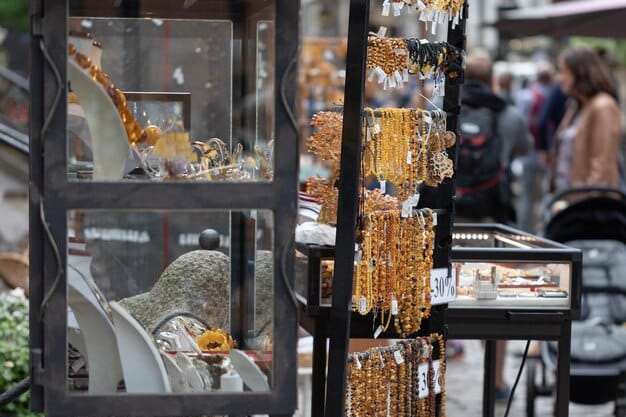
Different distribution channels also have varying cost structures. Selling directly to consumers through a brand’s own website or flagship stores often allows for slightly lower prices as it cuts out the middleman, but the brand then absorbs all marketing and logistical costs. Selling through major department stores or luxury boutiques, while offering wider exposure, incurs slotting fees, commissions, and often requires brands to adhere to stricter merchandising guidelines, all of which contribute to the final price.
Navigating the Complexities of Logistics and Import Duties
The global nature of fashion jewelry production means that logistics and shipping costs can add a significant layer to pricing. Transporting goods from manufacturing hubs to markets worldwide involves freight charges, customs duties, import taxes, and warehousing fees. These costs are ultimately passed down to the consumer.
- Supply Chain Efficiency: An inefficient supply chain with multiple intermediaries will result in higher costs passed on to the consumer.
- Logistics and Shipping: International shipping, expedited delivery, and secure transport for valuable items all add to the price.
- Retail Overhead: Operating brick-and-mortar stores or robust e-commerce platforms incurs substantial fixed and variable costs.
- Inventory Management: The cost of holding inventory, especially for seasonal fashion items, and the risk of unsold stock are factored into pricing strategies.
The journey of fashion jewelry from its point of origin to your hands is fraught with various operational costs and profit margins at each stage. These retail markups and distribution complexities are a fundamental reason why the final price you pay differs significantly from the initial manufacturing cost.
Economic Factors and Consumer Behavior: Supply, Demand, and Desirability
Beyond the tangible costs of materials, design, branding, and distribution, the pricing of fashion jewelry is profoundly influenced by broader economic factors and the intricate dynamics of consumer behavior. These forces, often driven by trends, perception, and market competition, play a pivotal role in shaping both supply and demand, ultimately dictating what consumers are willing to pay.
At its core, the principle of supply and demand applies. If a particular style of fashion jewelry becomes immensely popular—perhaps due to celebrity endorsement or a viral social media trend—demand will surge. If the supply is limited, or manufacturers are slow to scale production, prices will naturally increase. Conversely, if a trend fades or the market becomes saturated with similar products, prices may drop as brands compete for consumer attention and try to clear excess inventory.
Economic conditions also have a direct impact. During periods of economic growth and high consumer confidence, people are generally more willing to spend on discretionary items like fashion jewelry, allowing brands to maintain higher price points. In contrast, during economic downturns, consumers become more price-sensitive, which can lead to discounts, promotions, and a shift towards more affordable options. Inflation, too, drives up the cost of raw materials, labor, and transportation, which are inevitably passed on to the consumer.
Consumer behavior is highly nuanced. The perceived value of fashion jewelry is not just about its utility but also about its emotional and symbolic significance. A piece might be purchased for self-expression, as a gift, to mark a special occasion, or simply to keep up with current trends. Brands skillfully tap into these motivations through targeted marketing and product positioning, enhancing a piece’s desirability beyond its physical attributes.
The Influence of Trends and Fast Fashion
The rise of fast fashion has significantly altered the landscape of fashion jewelry pricing. This model thrives on quick cycles of design, production, and distribution, bringing trendy items to market rapidly and at low prices. While this benefits consumers looking for affordable, current styles, it also puts pressure on traditional brands to remain competitive, often leading to a dual pricing structure where some pieces are designed for longevity and others for fleeting trends.
- Trend Cycles: Rapid changes in fashion trends can lead to quick markdowns on out-of-season items, or premium pricing for ‘must-have’ pieces.
- Market Saturation: A flooded market with similar products can drive prices down due to intense competition.
- Economic Climate: Recessions typically lead to more conservative spending habits, favoring lower-priced fashion jewelry.
- Consumer Psychology: Perceived rarity, brand exclusivity, and the desire for self-expression contribute to willingness to pay.
Ultimately, the price of fashion jewelry is a dynamic reflection of how supply meets demand, influenced by macro-economic forces, the accelerated pace of fashion trends, and the ever-evolving desires and spending habits of the modern consumer. It’s a complex dance between tangible costs and intangible perceptions.
The Ethical Dimension: Sustainability, Labor, and Transparency
In the evolving landscape of consumer consciousness, the ethical dimension of production is increasingly influencing the pricing of fashion jewelry. Consumers are becoming more aware not just of what goes into their accessories, but also of how and by whom they are made. This shift toward responsible consumption brings sustainability, fair labor practices, and transparency to the forefront, adding new layers to the cost structure and value proposition of fashion jewelry.
Brands committed to ethical sourcing often incur higher costs. This can involve paying fair wages to artisans and factory workers, ensuring safe working conditions, and adhering to strict environmental regulations in manufacturing processes. These practices often contrast with the cost-cutting measures employed by some mass-market producers, where labor may be exploited or environmental protections may be disregarded. When a brand invests in certifications for fair trade, conflict-free materials, or environmental stewardship, these audits and compliance measures add to their operational expenses.
Sustainability initiatives, such as using recycled metals, upcycled materials, or sustainable packaging, also contribute to higher production costs. Developing and implementing eco-friendly manufacturing processes—like reducing water usage, minimizing waste, or utilizing renewable energy—requires significant investment in technology and infrastructure. These efforts, while beneficial for the planet, are often reflected in the final price of the jewelry.
Transparency is another key aspect. Brands that are open about their supply chains, from material sourcing to manufacturing locations and labor practices, build trust with consumers. This level of transparency, while valued, often comes with administrative costs, as it requires diligent record-keeping, supplier vetting, and public reporting. Consumers who prioritize these values are typically willing to pay a premium for products that align with their ethical stance.
The Growing Demand for Responsible Production
The market for ethically produced fashion jewelry is growing, albeit slowly. Brands that embrace these practices are often targeting a niche segment of consumers who are willing to pay more for products that reflect their values. This demand creates a justification for higher, more responsible pricing models.
- Fair Labor Practices: Ensuring living wages, safe conditions, and no child labor adds significant costs over exploitative practices.
- Environmental Responsibility: Sustainable materials, waste reduction, and eco-friendly manufacturing processes are more expensive but reduce ecological impact.
- Supply Chain Transparency: Vertically integrated brands or those with audited supply chains incur costs for tracking and verification.
- Certifications: Obtaining and maintaining certifications (e.g., B Corp, Fairmined) requires investment and adds credibility.
Ultimately, the ethical dimension in fashion jewelry pricing reflects a growing recognition that true value extends beyond mere aesthetic appeal. It encompasses the human and environmental costs of production, suggesting that paying a little more can contribute to a more just and sustainable industry.
| Key Factor | Brief Description |
|---|---|
| ✨ Materials & Quality | Plating thickness, synthetic stone quality, and hypoallergenic properties directly influence cost. |
| 🎨 Design & Craftsmanship | Originality, complexity of construction, and hand-finishing elevate design costs. |
| 🏷️ Brand & Marketing | Brand reputation, advertising campaigns, and perceived exclusivity add significant markups. |
| 📈 Retail & Logistics | Distribution channels, retail space, staffing, and shipping costs are major factors in final price. |
Frequently Asked Questions About Fashion Jewelry Pricing
▼
The price of fashion jewelry extends beyond material cost. It factors in intricate design, research and development, skilled craftsmanship, brand reputation, extensive marketing, and the overheads of distribution channels and retail operations. These elements contribute significantly to perceived value, making some pieces command higher prices despite using non-precious materials.
▼
Brand name significantly impacts pricing due to established trust, perceived quality, and aspirational value. Brands invest heavily in marketing, celebrity endorsements, and creating an exclusive retail experience, all of which consumers consciously or unconsciously pay for. This brand equity allows them to charge a premium over unbranded or lesser-known alternatives.
▼
Yes, brands prioritizing ethical sourcing, fair labor practices, and sustainable production often incur higher costs. These include fair wages, safe working conditions, transparent supply chains, and eco-friendly manufacturing processes. Consumers increasingly value these efforts and are often willing to pay a premium for jewelry produced responsibly, reflecting a broader shift in consumer values.
▼
Retail markups are a major component of fashion jewelry prices. These markups cover expenses such as rent, staff salaries, utilities, marketing, inventory management, and profit margins for wholesalers and retailers. Markups can range from 100% to over 500% from wholesale cost, making it a critical factor in the price you pay at the store or online.
▼
Assessing value involves considering material quality (e.g., plating thickness, stone clarity), design originality, craftsmanship, and brand reputation for durability. Look for pieces that offer unique aesthetic appeal and sturdy construction rather than just a low price. Researching the brand’s practices and reading reviews can also provide insights into the overall value proposition.
Conclusion
Unraveling the complexities behind fashion jewelry pricing reveals a multifaceted landscape where traditional material value often takes a backseat to a host of other influential factors. From the intricate artistry of design and the strategic prowess of branding to the practicalities of distribution and the ethical demands of modern consumers, what you pay for in fashion jewelry is a dynamic blend of tangible costs and intangible perceptions. Understanding these elements empowers consumers to make more informed choices, appreciating that each piece carries a story—not just in its aesthetic, but in its very creation and journey to the market.
